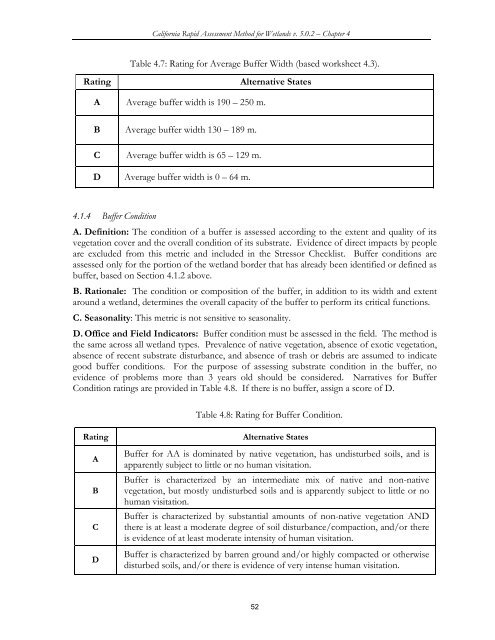(CRAM) For Wetlands User's Manual Version 5.0.2
(CRAM) For Wetlands User's Manual Version 5.0.2
(CRAM) For Wetlands User's Manual Version 5.0.2
Create successful ePaper yourself
Turn your PDF publications into a flip-book with our unique Google optimized e-Paper software.
California Rapid Assessment Method for <strong>Wetlands</strong> v. <strong>5.0.2</strong> – Chapter 4<br />
Table 4.7: Rating for Average Buffer Width (based worksheet 4.3).<br />
Rating Alternative States<br />
A Average buffer width is 190 – 250 m.<br />
B Average buffer width 130 – 189 m.<br />
C Average buffer width is 65 – 129 m.<br />
D Average buffer width is 0 – 64 m.<br />
4.1.4 Buffer Condition<br />
A. Definition: The condition of a buffer is assessed according to the extent and quality of its<br />
vegetation cover and the overall condition of its substrate. Evidence of direct impacts by people<br />
are excluded from this metric and included in the Stressor Checklist. Buffer conditions are<br />
assessed only for the portion of the wetland border that has already been identified or defined as<br />
buffer, based on Section 4.1.2 above.<br />
B. Rationale: The condition or composition of the buffer, in addition to its width and extent<br />
around a wetland, determines the overall capacity of the buffer to perform its critical functions.<br />
C. Seasonality: This metric is not sensitive to seasonality.<br />
D. Office and Field Indicators: Buffer condition must be assessed in the field. The method is<br />
the same across all wetland types. Prevalence of native vegetation, absence of exotic vegetation,<br />
absence of recent substrate disturbance, and absence of trash or debris are assumed to indicate<br />
good buffer conditions. <strong>For</strong> the purpose of assessing substrate condition in the buffer, no<br />
evidence of problems more than 3 years old should be considered. Narratives for Buffer<br />
Condition ratings are provided in Table 4.8. If there is no buffer, assign a score of D.<br />
Table 4.8: Rating for Buffer Condition.<br />
Rating Alternative States<br />
A<br />
B<br />
C<br />
D<br />
Buffer for AA is dominated by native vegetation, has undisturbed soils, and is<br />
apparently subject to little or no human visitation.<br />
Buffer is characterized by an intermediate mix of native and non-native<br />
vegetation, but mostly undisturbed soils and is apparently subject to little or no<br />
human visitation.<br />
Buffer is characterized by substantial amounts of non-native vegetation AND<br />
there is at least a moderate degree of soil disturbance/compaction, and/or there<br />
is evidence of at least moderate intensity of human visitation.<br />
Buffer is characterized by barren ground and/or highly compacted or otherwise<br />
disturbed soils, and/or there is evidence of very intense human visitation.<br />
52















